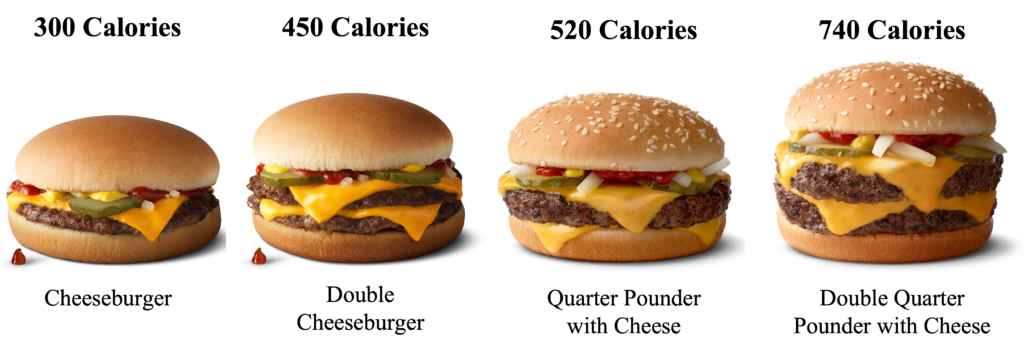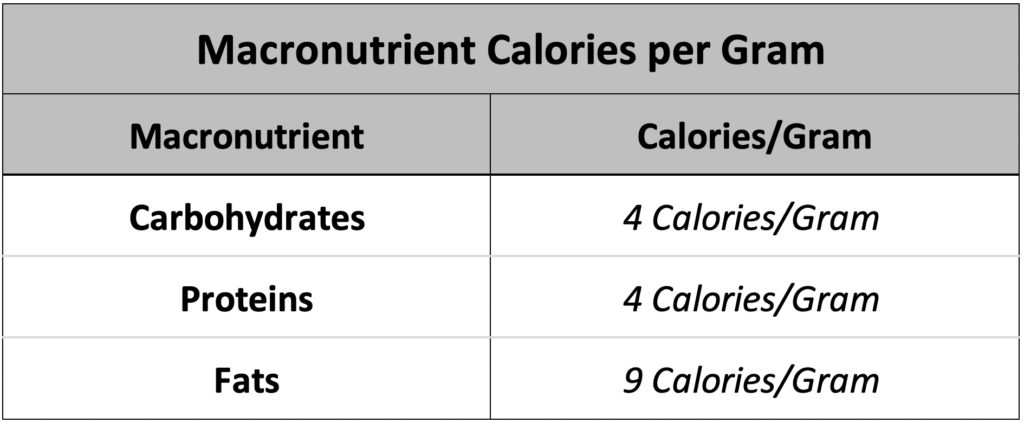There are three (and only three) ways to incur a caloric deficit: portion size, food frequency, and energy density.
- Portion Size: the quantity of food you eat at one sitting, per food source or at one meal.
- Food Frequency: how often (frequently) you eat through the day or how frequently you consume a food over a given time period (i.e., weeks or months).
- Energy Density: how much energy (calories) are packed into a given food.
Portion Sizes
Portion size advice tends to be pretty standard. Decrease your portion sizes to decrease the number of calories you are consuming. For example, if you typically eat a quarter pounder with cheese at McDonalds but downsize to a cheeseburger, you’ll save yourself 220 calories (Figure 07.1). Most people can fit a 300 calorie cheeseburger into their diet, even if your goal is weight loss. But most people don’t order a regular cheeseburger at McDonalds.

Food Frequency
The advice given in terms of how frequent you eat couldn’t be more confusing. Some people will tell you to eat multiple small meals/day while others will give you the exact opposite advice in the way of alternate-day-fasting or time restricted feeding.
The premise behind the advice to consume small frequent meals is to keep your metabolic rate high, prevent you from going into “starvation mode”, keep your blood sugar regulated, and prevent you from getting too hungry and overeating at your next meal.
There are different variations of alternate-day-fasting (ADF) but in nutshell ADF is modeled after an ancestral feast or famine type of eating pattern. ADF works by splitting your eating into two-day time blocks. On day one you will eat the majority of your food, let’s say 125% (feast) of the daily calorie intake required to maintain your body mass while on the other day you eat 25% (famine) of the daily calorie intake to maintain your body mass. By eating 125% and 25% (150%) you fall short of the two-day requirement to maintain your body mass (200%) and therefore lose weight.
Time restricted feeding (TRF) also comes in various forms. For example, in TRF you limit the number of hours during the day that you allow yourself to consume food or drinks with calories. Maybe you only eat or drink food with calories during a 6-, 8- or 10-hour time block (i.e., 10am to 6pm in the case of 8-hour time restricted feeding). TRF severely limits the opportunities to consume calories during the day.
Research shows that eating multiple small meals/day, alternate-day fasting, or time-restricted eating is not better or worse than other forms of caloric restriction. While there are sure to be people who have lost weight employing each of these strategies, do you really want to eat this way for the rest of your life?
At The Science of Dieting we recommend you do what is best for your schedule and preferences. If that means eating two meals, eat two, if that means eating eight meals, eat eight. Provided you can stay in a negative energy balance you are going to lose weight.
Energy Density
Although they are roughly the same size, there are far more calories in a stick of butter than in a banana. Common nutrition advice is to eat more fruits and vegetables because they are nutrient dense rather than energy dense. But oftentimes the opposite advice is also given.
High-fat, high-protein, and some low-glycemic advocates will argue that fruits and vegetables contain too much carbohydrate, will spike insulin levels, and promote fat storage rather than fat burning. This argument could possibly be made for ultra-processed carbohydrate (i.e., soda, cookies, cake) but is ridiculous when used against fruits and vegetables. Yes, ultra-processed carbohydrates and fruits are both carbohydrates but they’re not even in the same ballpark.
Fat is the most energy dense macronutrient (9 calories/gram) while protein and carbohydrate both contain 4 calories/gram. You can eat twice as much carbohydrate or protein and still not eat as many calories as you would with an equivalent amount of fat (Table 07.1).

And yet, many diets (i.e., Paleo, Keto, Atkins, Low-Carb) recommend eating a high fat diet. Why? Because they claim that fat is more satiating and keeps you feeling fuller longer, thereby reducing the need to eat as soon (reducing your food frequency) and possibly reducing your portion size as well. Here again, however, the theory behind the diet and the efficacy of the diet doesn’t really match. Low-carb, high-fat diets are not more successful in the long-term than high-carb, low-fat diets.
Without getting too deep in the weeds, I will mention that low-carb advocates will cite scientific literature showing that low-carb diets cause significantly more weight loss than low-fat diets. While they may be statistically “significantly” different, there is typically only a few pounds difference between the diet types and neither diet produces the amount of weight loss sought by the individual dieting.
Foods that tend to be most problematic for weight loss (and weight gain) tend to be savory, that is, they contain lots of carbohydrate AND lots of fat. In and of itself, one can of Coca Cola isn’t going to kill your diet (~150 calories). But if are consuming a big gulp (portion size) or a six pack per day (frequency), then you are definitely going to get derailed. The same could be said for potato chips and numerous other carbohydrate-based snack foods. However, when you get into baked goods, fatty meats, and food cooked in oil, you are going to really have to control your portions and food frequency to keep your calories low.
The most common advice for controlling energy density is to substitute out higher energy density foods for lower density foods or changing your cooking methods. For example, deep frying French fries is super high calorie, baking French fries, not so much. But you need to be careful with substitutions because before you know it you’ll be using sugar free syrup on your pancakes, guzzling Diet Cokes, eating low-fat cheese on diet bread. While none of these foods will help or harm weight loss per se, something just feels a little off about consuming foods so “unnatural”.
The bottom line is that the topic of energy density requires a more nuanced discussion than we are able to provide here but our advice would be to keep your substitutions as “natural” and minimally processed as possible. Doing so should help you reduce the number of very high calorie, energy dense foods you are consuming.
Conclusion
It is impossible to tell you everything you need to know about portion size, food frequency, and energy density in one webpage. However, as a start, we would recommend that you
- Decrease portion size whenever possible, with the exception of fruits and vegetables. In that case you should strive to increase portion size (if you are eating them, but don’t force yourself to eat them).
- Whether you eat 2 meals/day or 8 meals/day has little bearing on how much weight you lose. What is important is the type of food(s) you are consuming and how frequently you consume those foods. Try to decrease the frequency with which you are consuming ultra-processed, highly palatable foods OR set guidelines for yourself for how much and how frequently you are able to consume those foods. Be careful here though because this can be a slippery slope.
- It is okay to eat foods that are energy dense but you will need to limit your portion size and food frequency when eating said foods. Turkey legs and French fries are energy dense foods that should not be eaten frequently and should be eaten in relatively small portions. But this doesn’t mean that they need to be avoided entirely.
You can have your proverbial cake and eat it too but you need to be able to balance portion size, food frequency, and energy density. No food should ever be totally off limits (unless you cannot control yourself around that food, then it will need to be off limits) provided you take portion size, food frequency, and energy density in consideration.
In our next section (08), we want to share with you why Diet is More Important than Exercise to Lose Weight.